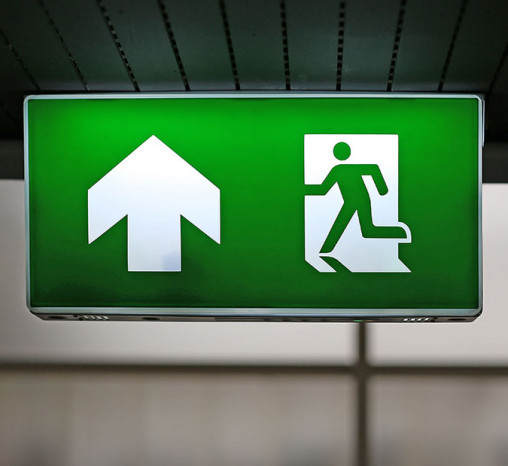10. Means of escape: Designing buildings for access and usability

Well-designed escape routes that meet the needs of all building users are critical in an emergency.
Emergency evacuation
The building and surrounding environment should be designed to allow for all occupants to evacuate the building and reach a safe place in the event of an emergency.
Users vary in their physical ability to be able to move quickly and use staircases, and in their ability to locate and follow signage. Evacuation strategies are essential to ensure everyone has an equal opportunity to escape in an emergency.
Wheelchair users have a particular problem in that most are unable to negotiate steps. Accessible doors and step-free exits in as many locations as possible are a distinct advantage.
Those who are blind or have low vision need to be aware of emergency egress routes, meeting points and the location of alerting systems.
In an emergency, building users will take the most direct route out of the building. All staircases should be easily usable by everyone.
In the event of a power cut, escalators may stop functioning, presenting users with a steep staircase with excessively high and changing risers with sharp nosings.
Some building users may not be able to use the stairs without assistance and there are building management requirements to ensure assistance is provided to them.
The Fire and Emergency NZ (Fire Safety, Evacuation Procedures, and Evacuation Schemes) Regulation 2018 (link to Regs) set out the requirements for assisted evacuation.
Design considerations
- As far as is possible, position the building in relation to the topography so that all floor levels provide level egress without steps to adjoining external areas.
- Ensure all doors on all circulation routes are wide enough to allow for the passage of wheelchairs.
- Ensure all staircases are usable by everyone able to walk.
- Consider the provision of evacuation lifts and refuges in very tall buildings.
- Ensure escalators are not used as part of an escape route.
Building Code requirement
Building Code clause C4 Movement to a place of safety:
C4.2 Buildings must be provided with means of escape to ensure that there is a low probability of occupants of those buildings being unreasonably delayed or impeded from moving to a place of safety and that those occupants will not suffer injury or illness as a result.
Practice Advisory 18: Fire Safety Design for Tall Buildings
Manual call points and alarms
Manual call points should be positioned in locations accessible to and usable by all users.
The identification of a reason to evacuate the building may be made by any building user. Call points should be positioned and usable by everyone.
Design considerations
- Provide easy to identify manual call points in logical positions capable of being used by everyone for the building’s emergency alarm system.
- Consider visual alarms in addition to aural alarms in toilets.
Building Code requirement
Building Code clause F7 Warning systems:
F7.2 Buildings shall be provided with appropriate means of warning people to escape to a safe place in an emergency.
Pager systems
Pager systems can be incorporated into a building where appropriate.
Pager systems linked to fire alarms can attract attention by vibrating and displaying warning information by text. This can be of great assistance to people with hearing impairment especially if there are staged evacuations, or if they are in a hotel room or other location on their own.
Vibrating pillow pads allow people with hearing impairment to be awoken from sleep.
Design considerations
- Incorporate pager systems where they would be appropriate such as for staff.
- Provide for vibrating pillow pads for issue by building management.
Fire safety signage
Appropriate fire safety signage should be provided in logical positions.
The knowledge of the location of escape routes is vital to the safe evacuation of building users. However, not everyone may be able to see the signage or understand it.
In wheelchair accessible hotel rooms, emergency evacuation notices need to be at the correct height and indicate what to do if the occupant is unable to use staircases.
Design considerations
- Ensure that appropriate fire safety signage is provided in logical positions.
Building Code requirement
Building Code clause F8 Signs:
F8.2 Signs must be provided in and about buildings to identify: (a) escape routes.
All guidance related to Buildings for everyone: Designing for access and usability